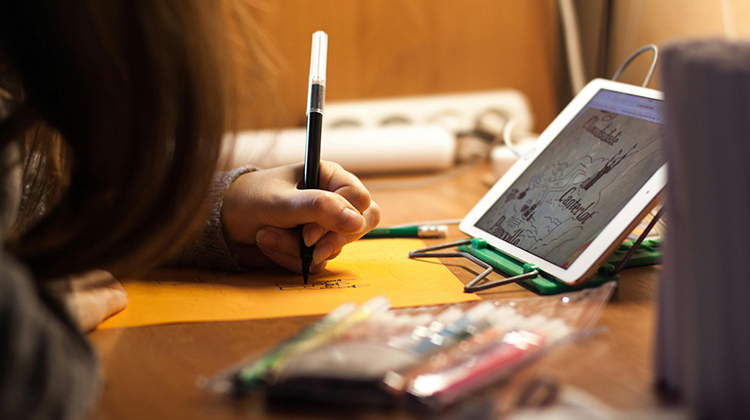AI Might Interfere with the Acquisition of Writing Skills

A growing number of generative artificial intelligence (AI) systems are starting to revolutionise written communication.
This digital shift is likely to impact writing acquisition and development, underlining the urgency of preparing beginning writers to become ‘hybrid writers’, able to produce paper and computer-generated texts with a similar level of proficiency.
Dr Anabela Malpique from Edith Cowan University (ECU) has highlighted the importance of teaching handwriting in primary school education and beyond, despite children growing up in a digital age.
“We argue that it is vital to teach handwriting in the first years of schooling and to continue supporting the development of handwriting skills across primary and secondary years. Handwriting skills are connected to improved spelling and greater capacity to write longer and higher-quality texts. Handwriting also promotes our capacity to learn and memorise information,” School of Education Senior Lecturer, Dr Malpique explained.
“Skilful writing is a powerful means of communication, and a key goal in educational contexts worldwide. Written words have shaped our cultures, defining our actions and thoughts as human beings.”
Digital Natives: Do Children Write Better on Paper or a Keyboard?
Dr Malpique and colleagues conducted a meta-analysis to examine studies published between 2000-2022, comparing the effects of writing by hand or keyboarding on primary students’ writing performance (Foundation-Year 6).
“It's often presumed that children are digital natives because they have grown up with different technologies around them - so they will be naturally able to write texts using digital devices,” Dr Malpique said.
The research findings showed that primary students produce higher quality writings using paper and pen(cil) than when using a keyboard.
In a recent large-scale project examining the writing performance of Year 2 children (544 students, 47 classrooms) in WA, it was also found that children wrote longer and higher-quality handwritten texts.
“One thing we do know is the importance of transcription skills. Transcription skills refer to spelling and how quickly and accurately children can handwrite or type, also called automaticity,” Dr Malpique added.
“Our research has consistently shown that young children’s spelling and capacity to automatise handwriting and typing predicts the quality and the length of their texts. Simply put, children can better focus on what they want to say when handwriting or typing becomes automatised.
“Writing resembles other complex skills, such as driving a car. Unless we automatise the management of gears, pedals, blinkers, and wipers (transcription skills) we cannot select the most efficient or the most scenic route (creating texts).”
Explicit Teaching of Handwriting and Keyboarding
Dr Malpique said teaching how to write letters is connected to children’s spelling and capacity to develop automaticity in writing texts by hand. Similarly, keyboarding needs to be taught.
“Keyboarding, much like handwriting involves a complex set of cognitive, visual & motor processes, requiring frequent practice and instruction.
“It involves learning the location of the keys on a keyboard, combined with spatial skills of positioning, and moving fingers to press the keys in the correct sequence. Students need time to practice so they can move beyond the “hunt and peck” motion, which is typical of novice keyboarders,” Dr Malpique said.
What can Teachers and Families do?
As a complex skill, writing needs practice and perseverance. By working in collaboration with families, teachers can maximise opportunities for practice and enjoyment of writing or typing:
• Dedicate time for practice: Teachers can build regular practice routines in class and send home mini-tasks such as 10-minute writing or spelling prompts (writing a shopping list; finish a story; spot the spelling mistakes)
• Become a fellow writer by modelling: This means joining the writing as opposed to “policing” the writing. As you write you can talk about what you will write (planning), and you can share ideas about how you can make your writing clearer or more exciting.
• Talk about your mistakes and find ways of correcting your writing: When adults talk about their errors or doubts, they make them a natural part of the process. When they correct them, they show children strategies to revise their own writing.
• Read what you have written: Reading what you have written provides opportunities for correction and celebration. Praise children’s risky attempts such as using new words or experimenting with expressions.
• Give children choice: The more children are in control of the process, the more likely they will enjoy it. They can choose topic, they can mix art and letters, they can choose paper or keyboard!
• Showcase the writing: Make children’s writing visible on your walls, on your fridge or as wallpapers on your devices. Writing samples can also be a great way to show children how much they have grown as writers.
• Aim for automaticity: Find opportunities that let children see the importance and purpose of writing and keyboarding in their daily lives.
The contributions of transcription skills to paper-based and computer-based text composing in the early years was authored by Dr Anabela Malpique, Dr Mustafa Asil, Associate Professor Deborah Pino-Pasternak, Professor Susan Ledger and Professor Timothy Teo.
Malpique, A., Valcan, D., Pino-Pasternak, D., Ledger, S., & Merga, M. (2023). Effects of writing modality on K-6 students’ writing and reading performance: A meta-analysis. The Australian Educational Researcher. https://doi.org/10.1007/s13384-023-00676-y
Image by jmark